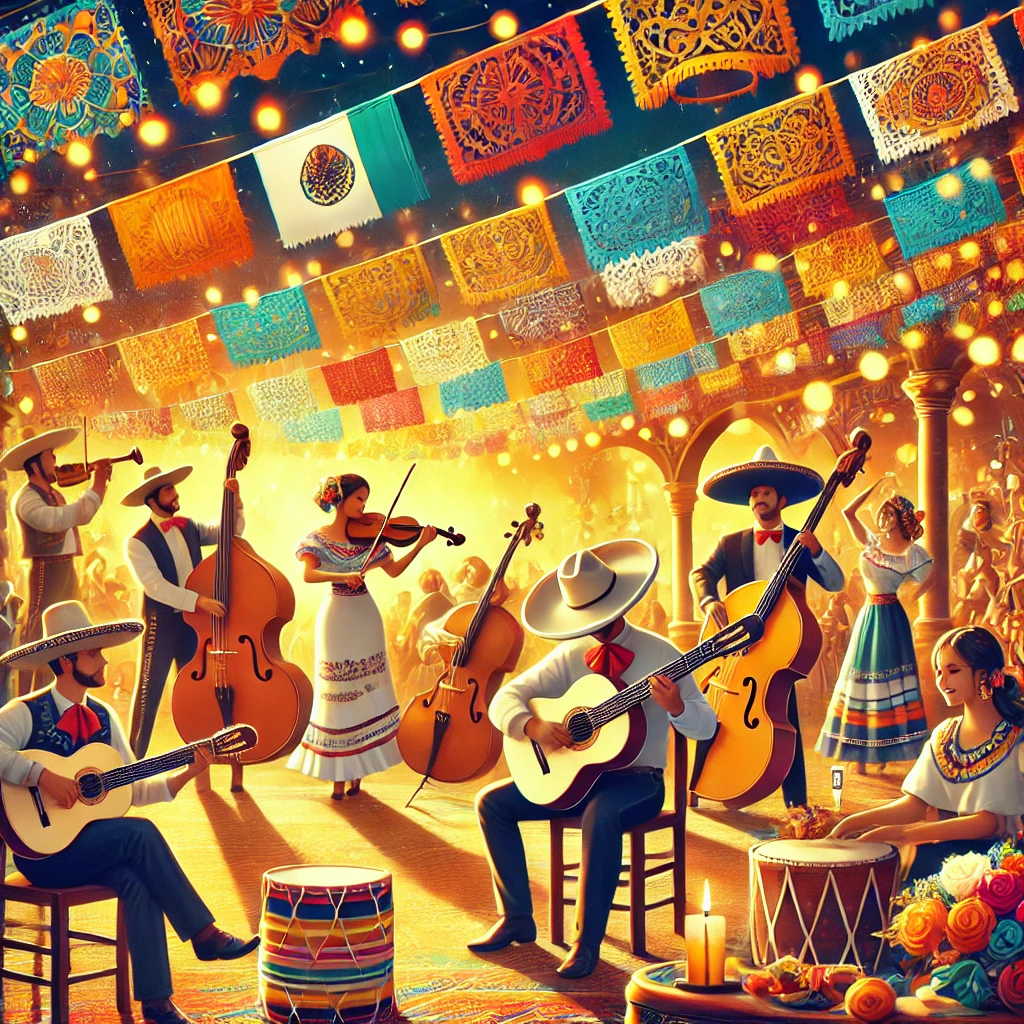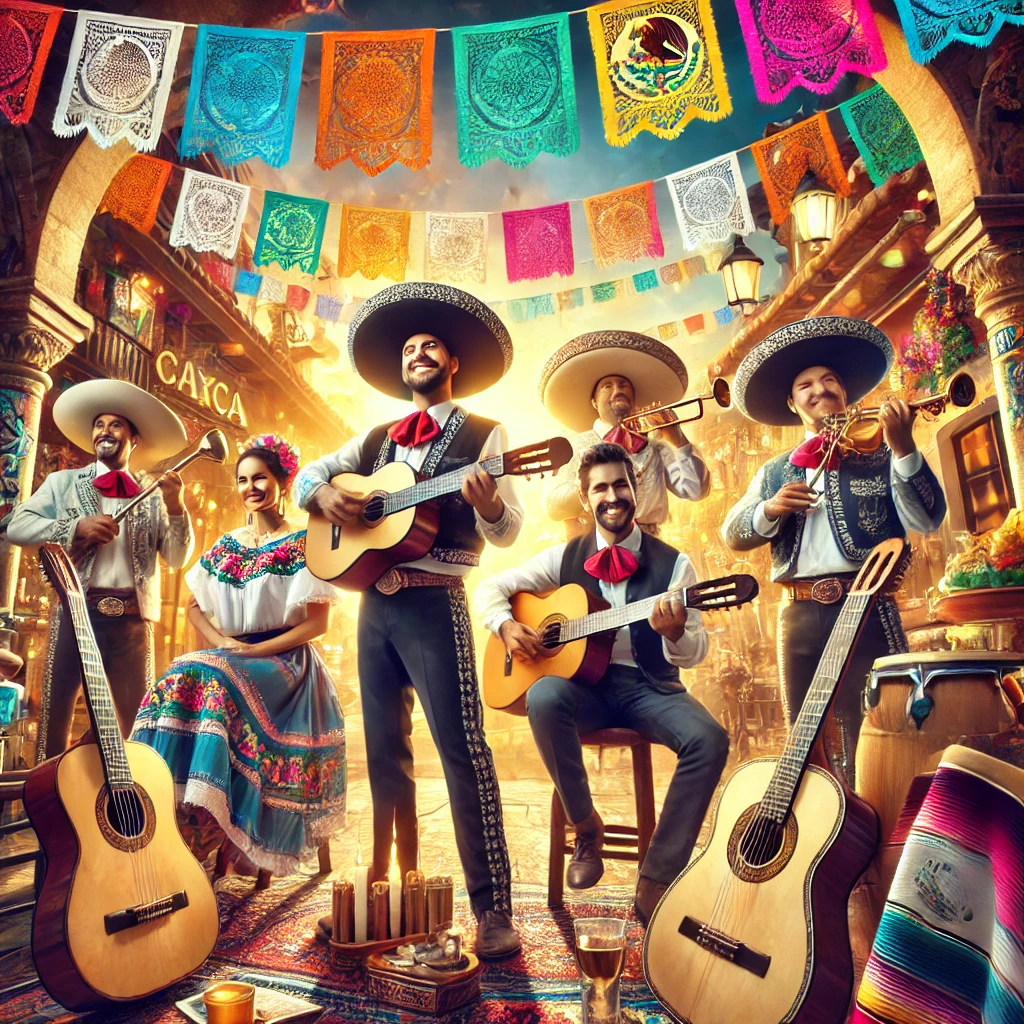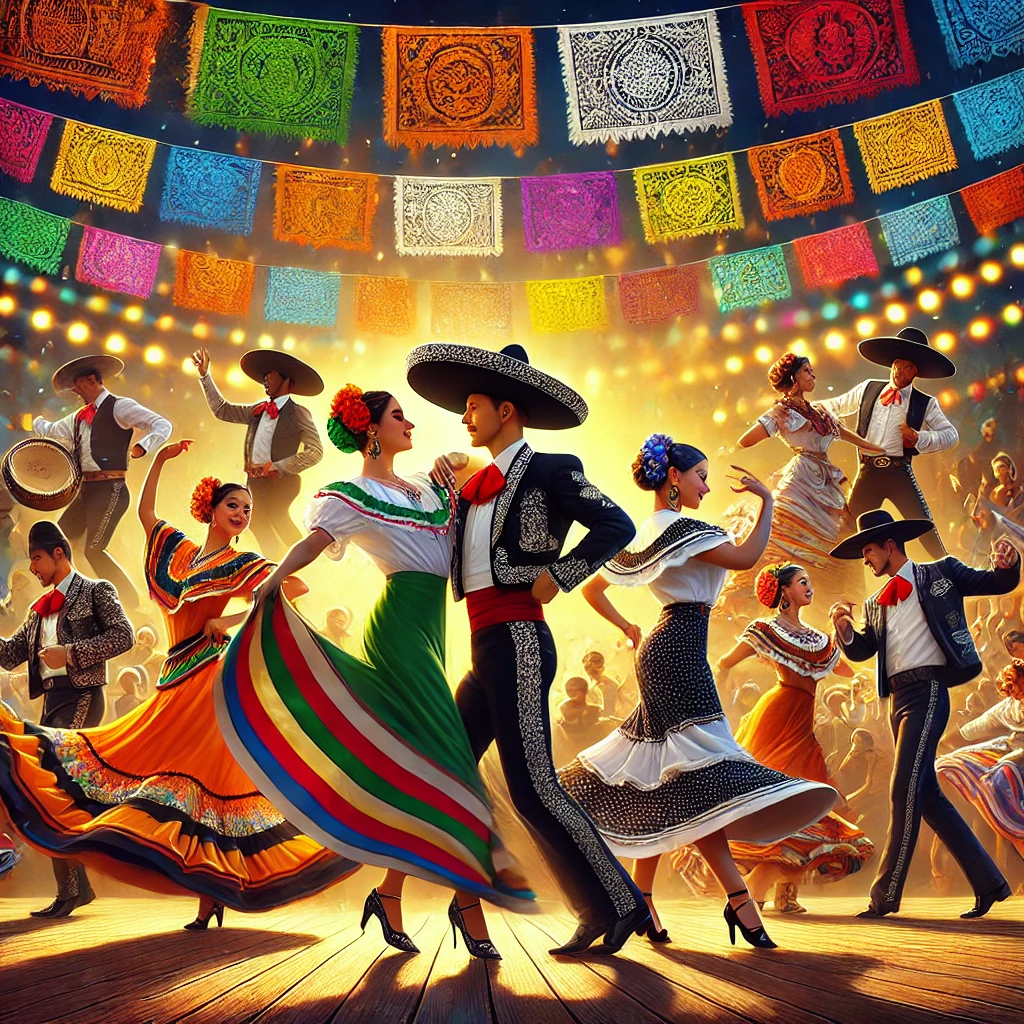Table of Contents
Introduction to Mexican Music
Mexican music is a vibrant and dynamic tapestry that embodies the rich historical, cultural, and social influences of the country. It plays an essential role in shaping the Mexican identity, providing a unique lens through which one can understand its diverse heritage. Originating from a blend of indigenous, Spanish colonial, and African influences, Mexican music is characterized by its various genres, instruments, and dance forms, which have evolved over centuries.
Music in Mexico serves multiple purposes, acting as a vital component of social and cultural events. It is woven into the fabric of celebrations, such as weddings, religious festivals, and national holidays, where traditional melodies often produce a sense of nostalgia and cultural pride. Genres like Mariachi and Ranchera are particularly significant, as they encompass not only musical elements but also storytelling that mirrors the struggles, joys, and traditions of Mexican life.
Furthermore, the significance of music extends beyond mere entertainment; it is a medium for communication and expression. Through various musical forms, artists convey emotions and social messages, challenging political circumstances and celebrating communal bonds. This sense of unity facilitated by music strengthens relationships among individuals and communities, and continues to be an important aspect of Mexican culture today.

As we delve deeper into this guide, we will explore the key genres such as Mariachi, Ranchera, and several others that highlight the multifaceted nature of Mexican music. Each genre tells its own unique story and contributes to the evolution of a national identity that is both rich and diverse, ultimately reflecting the collective experiences of the Mexican people.
Understanding Ranchera: The Heart of Mexican Folk Music
Ranchera music stands as a fundamental pillar of Mexican folk music, reflecting the country’s rich cultural heritage and emotional depth. Its origins can be traced back to the rural landscapes of Mexico in the late 19th century, stemming from a blend of indigenous, Spanish, and African musical influences. This genre encapsulates the essence of everyday life experiences, with themes revolving around love, heartbreak, nature, and the struggles inherent in rural living.
The emotive power of Ranchera music is typically conveyed through its poignant lyrics, which resonate with listeners and evoke feelings of nostalgia. The narrative style often focuses on personal stories that reveal the complexities of human emotions, particularly love and loss. These songs frequently reflect the trials of romantic relationships or the profound connection to the land. Notable artists, such as José Alfredo Jiménez, Vicente Fernández, and Pedro Infante, have contributed significantly to the popularization of Ranchera through their timeless compositions and performances. Iconic songs such as “El Rey” and “La Culebra” serve as quintessential examples of the genre, showcasing its depth and appeal.
Instrumentation plays a crucial role in the presentation of Ranchera music. Traditional performances typically feature instruments such as the guitar, trumpet, and violin, along with the distinctive mariachi ensembles that have become synonymous with this style. The combination of these instruments adds a rich layer to the sound, enhancing the emotional weight carried by the lyrics. The mariachi band, particularly, has been instrumental in elevating Ranchera music to broader audiences beyond Mexico, fostering cultural exchanges and appreciation of this folk art form across the globe.
Moreover, Ranchera music occupies a significant place in various Mexican traditions and celebrations, underscoring its importance in the social fabric of the nation. Its lively rhythms and passionate melodies make it a beloved genre that continues to thrive and evolve, ensuring that Ranchera remains an enduring force in the world of music.
Mariachi: The Iconic Ensemble of Mexico
Mariachi music, with its vibrant melodies and lively rhythms, serves as a vital representation of Mexico’s rich cultural heritage. Originating in the 19th century, Mariachi groups began as small ensembles performing in the western states of Jalisco and Nayarit. These traditional bands initially consisted of only a couple of violins, a guitar, and a harp. Over the years, however, they evolved into larger ensembles, incorporating a diverse range of instruments including trumpets, vihuelas, and guitarrones. Today, a typical Mariachi band features anywhere from three to twenty musicians dressed in elaborate charro suits, symbolizing the traditional attire of Mexican cowboys.
The essence of Mariachi music lies in its ability to convey emotion and storytelling, often reflecting themes of love, heartbreak, and celebration. As an integral part of various cultural events, Mariachi performances are a staple at weddings, birthdays, and festivals, where they elevate the atmosphere with their spirited tunes. The infectious nature of Mariachi has led it to become a beloved musical form not only within Mexico but also in various parts of the world, where it has gained immense popularity.
Famed Mariachi groups such as Mariachi Vargas de Tecalitlán and Gama 1000 have significantly contributed to the genre’s international acclaim. The former group, noted for its innovative arrangements and theatrical performances, has set the standard for Mariachi music since the early 20th century. Furthermore, the widespread use of Mariachi in films and television has solidified its position as a representation of Mexican culture on a global scale, making it synonymous with celebratory occasions.
Norteño: The Sound of the North
Norteño music, a vibrant genre originating from the northern states of Mexico, embodies a cultural tapestry woven with rich history and diverse influences. Characterized predominantly by the use of the accordion and the bajo sexto, Norteño reflects the regional experiences and traditions of its people. This genre forms a poignant connection to the past, with roots tracing back to the 19th century, when German and Czech immigrants introduced instruments that became integral to the Mexican musical landscape.
Thematically, Norteño often explores subjects such as love, loss, and the struggle of everyday life, drawing listeners into its melodic storytelling. Through its narratives, the music serves not only as entertainment but also as a means of expressing the challenges faced by rural communities, as well as their joys and aspirations. Unlike other Mexican music styles, such as Mariachi or Ranchera, which often emphasize grand themes, Norteño tends to focus on more personal stories, creating an intimate bond between the performer and the audience.
Ultimately, Norteño music stands as an essential expression of the cultural identity of northern Mexico, encapsulating the heart and soul of its communities while continuing to thrive amidst changing times.
Bolero: The Romance of Mexican Music
Bolero, a genre that evokes deep emotion and romance, has a significant place in the landscape of Mexican music. Originally emerging in the late 19th century from Cuba, Bolero quickly transcended its geographical roots, integrating seamlessly into Mexican culture and music. Its characteristic rhythmic patterns and expressive melodies are celebrated for their ability to convey longing and passion, making it a beloved fixture in romantic music playlists.
The Bolero genre is distinguished by its smooth, flowing rhythms and lyrical content that often explores themes of love, heartache, and desire. Notable Bolero songs include classics such as “Bésame Mucho,” composed by Consuelo Velázquez, which has been interpreted by various artists worldwide. This particular song embodies the essence of Bolero’s romantic appeal, characterized by intimate and heartfelt lyrics. Additionally, “Perfidia,” written by Alberto Domínguez, stands as another timeless piece that showcases the genre’s hallmark emotional complexity.
Throughout the years, many artists have made significant contributions to the Bolero genre, enhancing its popularity and deepening its emotional narratives. Renowned singers such as Luis Miguel and the legendary Trio Los Panchos have played pivotal roles in popularizing Bolero songs, both domestically and internationally. Their interpretations often blend the classic elements of Bolero with contemporary styles, thereby reaching a broader audience and introducing new listeners to its rich traditions.
Moreover, the emotional depth found in Boleros is not only a testament to the genre itself but also reflects the cultural sentiments prevalent in Mexican society. The melodies act as a medium to articulate feelings that can sometimes be challenging to express in words. As Bolero continues to evolve, it remains a cherished expression of romance and affection, making it an enduring cornerstone of Mexican musical heritage.
Cumbia: The Dance of Celebration
Cumbia is a vibrant and joyous music genre that has become a significant cultural hallmark in Mexico and Latin America. Its origins can be traced back to the coastal regions of Colombia during the 19th century, where indigenous, African, and European musical elements converged. This rich fusion laid the groundwork for what would become a lively genre characterized by its infectious rhythms and energetic melodies.
As Cumbia spread throughout Latin America, it underwent numerous transformations, incorporating diverse local influences. In Mexico, it blossomed into various styles, including the traditional Colombian Cumbia, the festive Cumbia tejana, and the contemporary Cumbia sonidera, each reflecting regional tastes and cultural contexts. The unique adaptations contributed to Cumbia’s evolution from its humble beginnings into a preferred choice for celebratory events, such as weddings, festivals, and parties.
The typical ensemble for a Cumbia performance includes instruments like the accordion, bajo sexto, and various percussion instruments, such as drums and maracas. The pulsating beat and melodic accordion lines invite listeners to dance, making Cumbia a quintessential element of social gatherings. The songs often feature themes of love, life, and nostalgia, encapsulating the essence of jubilant celebration that resonates deeply within the Mexican culture.
The infectious nature of Cumbia has not only captivated local audiences but also gained international recognition, leading to its incorporation into various music genres, including pop, hip-hop, and electronic music. This cross-genre fusion has significantly contributed to Cumbia’s enduring popularity, allowing it to thrive in contemporary settings while still honoring its rich heritage. Cumbia truly embodies the spirit of celebration, uniting people across cultures and generations through the power of music and dance.
Son Jarocho: The Cultural Legacy of Veracruz
Son Jarocho is a vibrant music genre that originated in the coastal region of Veracruz, Mexico. This style is distinguished by its rich mixture of cultural influences, combining elements of African, Spanish, and indigenous music traditions. It is through these diverse roots that Son Jarocho embodies the unique cultural tapestry of Mexican heritage, making it a significant part of the country’s musical landscape.
At the heart of Son Jarocho are traditional instruments such as the jarana and the requinto. The jarana is a small guitar-like instrument traditionally made from wood, while the requinto is a higher-pitched guitar used for lead melodies. Together, these instruments create a lively and rhythmic sound that is synonymous with regional celebrations. The lively strumming of these instruments, paired with lively lyrics often centered around love, nature, and daily life, form the backbone of the Son Jarocho experience.
In addition to its musical elements, Son Jarocho plays a vital role in various traditional Mexican celebrations. It is frequently performed at vibrant festivals, such as the Festival del Son Jarocho in the town of Tlacotalpan. This festival draws musicians and dancers from across Mexico, highlighting the importance of Son Jarocho in preserving and promoting cultural identity. During these events, participants engage in spirited jarocho dances, utilizing foot stomping and lively movements that enhance the music’s infectious energy.
The significance of Son Jarocho cannot be underestimated; it serves as a joyful expression of community, culture, and the shared heritage of the Veracruz region. Through its continued celebration and practice, Son Jarocho remains a testament to the enduring legacy of Mexican music, fostering connections across generations and communities.
Modern Mexican Music: Fusion and Innovation
Modern Mexican music is a vibrant tapestry, woven from traditional strands and contemporary influences. As the global music landscape evolves, so too does the soundscape of Mexico, reflecting a rich fusion of genres that borrow from both local and international traditions. This innovative spirit can be seen in various popular genres, such as Mexican rock, pop, and hip-hop, where traditional elements are intermingled with diverse musical influences.
Mexican rock emerged as a powerful genre in the 1960s and 1970s, characterized by its blend of rock’s energetic rhythms with the rich melodies of folk traditions. Bands like Café Tacvba have played a pivotal role in this genre’s evolution, merging rock with son jarocho and other regional sounds. Their pioneering approach has influenced a new generation, demonstrating how traditional music can innovate while retaining its cultural roots.
In the realm of pop music, there has been a notable shift towards incorporating regional sounds and instruments. Artists like Natalia Lafourcade and Leonel García have seamlessly integrated mariachi influences and folkloric rhythms into their works, creating a distinct sound that appeals to a modern audience while respecting tradition. Similarly, the rise of hip-hop in Mexico has led to a dynamic fusion with local styles, as seen in the works of artists like C. Tangana and Santa Fe Klan. This blending not only elevates the musical narrative but also reflects the sociocultural landscape of the country.
The incorporation of diverse styles is a testament to the resilience and adaptability of Mexican music. As artists continue to experiment by bridging the gap between the old and the new, they are forging a unique path that honors the past while embracing the possibilities of the future. This ongoing dialogue between genres will undoubtedly ensure that Mexican music remains a significant force in the global music scene, exemplifying innovation through fusion.
Conclusion: The Future of Mexican Music
Throughout this exploration of Mexican music, we have traversed a rich tapestry of genres that celebrate the country’s diverse cultural heritage. From the passionate rhythms of Ranchera to the festive allure of Mariachi, each musical style offers a unique reflection of the lives and traditions of the Mexican people. The journey through these various genres reveals not only their historical significance but also the continued relevance they hold in contemporary society.
The evolution of Mexican music is an ongoing process, characterized by its ability to adapt and integrate new influences while maintaining its traditional roots. The fusion of modern genres with classical forms demonstrates the dynamic nature of this musical landscape. Artists are increasingly experimenting with contemporary sounds, blending electronic elements with age-old melodies, which expands the appeal of Mexican music to a broader audience. This cultural dialogue is essential for the longevity of the genre, allowing it to remain vibrant and relevant amidst changing tastes.

Preserving traditional music is crucial; it connects future generations with their cultural identity and history. Efforts are being made by various organizations and community groups to ensure that traditional forms such as Son Huasteco and Banda continue to be practiced and appreciated. At the same time, the rise of new artists often brings fresh interpretations and innovative sounds that move away from strictly traditional frameworks. These new voices are crucial in shaping the future of Mexican music, attracting younger audiences, and ensuring that this cultural heritage thrives.
In conclusion, the future of Mexican music is promising. It stands at the crossroads of tradition and modernity, with artists harnessing the best of both worlds. As listeners, it is our privilege to explore and appreciate this vibrant musical heritage, supporting the artists who contribute to its evolution and enrichment. Through this exploration, one can truly understand the heart and soul of Mexico encapsulated in its music.






Yes you the talented person
Helpful info. Lucky me I found your website accidentally, and I’m shocked why this coincidence didn’t took place
in advance! I bookmarked it.